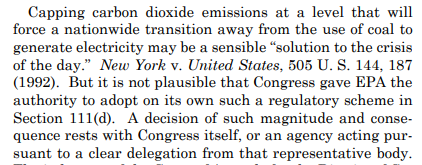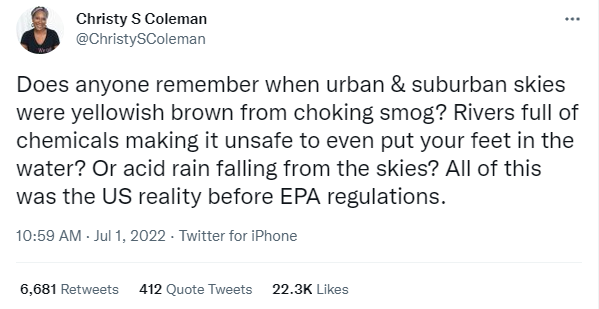06 July 2022 | Climate Tech
Live to regulate another day
By
West Virginia v EPA
One piece of news we didn’t cover in the weekend’s email? The Supreme Court’s ruling in West Virginia v EPA. While I want to spend some time there today, I didn’t rush to write about it because plenty of other folks did. Whether you prefer Bloomberg, the New York Times, or your Twitter feed, you could find solid coverage of the topic on each.
At the same time, there was also a lot of hyperbolic coverage, which I get. Considering the magnitude of other recent decisions and the fallout for people’s health in this country, I’d be the last to dissuade anyone from being incensed. Still, concerning West Virginia v EPA, that was the other reason I didn’t rush to cover it immediately – in the imminent aftermath, things were pretty noisy!
So, what’s the key takeaway from this ruling? Time to take a look.
Live to regulate another day
Primarily, the ruling will prevent the EPA from enacting sweeping restrictions on GHG emissions that would necessitate a shift away from coal and natural gas power plants in the U.S. The court expressly referred to proposed caps on emission from power plants in the U.S. that the EPA has considered, suggesting the EPA has not been granted the authority to enact such systems by Congress:
If we’d woken up one day and the EPA had enacted a nationwide emission cap, even if it had scaled up progressively over decades, I would have been shocked. That would have represented a decision of significant “magnitude and consequence,” and I would have been surprised to learn the EPA had the authority to do it.
I would have, of course, been happy, too. I’m not saying I agree with the court’s ruling (I don’t know nearly enough about the law). My point is that I’m not sure how many people had the EPA enacting these types of restrictions on their 2022 bingo card anyways. The court’s ruling does not:
- Get rid of existing regulations or limit the EPA’s ability to update them
- Hamstring the EPA from making new regulations, especially those that ‘look similar’ to previous ones
- Prevent the EPA from making new regulations about greenhouse gasses
- Prevent the EPA from going after specific power plants or types of power plants and types of emissions on a case-by-case basis
In short, the below is not what we’re headed back towards…
The more significant concern heading into the ruling was whether the Supreme Court would entirely curtail Congress’ ability to delegate authority to agencies like the EPA. An extreme ruling like that would prevent them from making new regulations, even if less sweeping than those the Supreme Court identified as being too significant in scope.
Unfortunately, the larger concern heading forward is whether the Supreme Court will hear another case that allows it to restrict the EPA – and other agencies — range of motion even more. The fact that this ruling was preemptive, i.e., it curtailed the EPA’s ability to do something before they even tried, suggests more may well be coming.
Zooming out, even if this ruling isn’t a death knell for the climate, voters broadly disagree with the outcome of the court’s decision. Even self-identifying Republicans are relatively split on the matter:
The net-net
Something I think some people still fail to appreciate about Trump’s years in office is how intentionally he fomented outrage. If people are outraged by something every day, over time, they become desensitized to any and all new information. This eventually breeds apathy.
The same is true in climate coverage and media. If each day is an onslaught of bad news, you get what some are already observing in younger generations, especially Millennials and Gen Z. They’re apathetic. And some think reversing climate change is a hopeless cause.
That’s why covering something like the Supreme Court’s ruling in West Virginia v EPA in the same breath as the court’s overturning of Roe v. Wade is misguided. Will it be harder for the U.S. to meet its 2030 and 2035 climate goals without sweeping new regulations on emissions? Probably. Was the U.S. on track to hit those goals before this ruling? Hardly. Is there plenty it can do absent emissions caps to meet them? Surely.
The EPA was unlikely to be the white knight in the U.S.’s crusade against climate change. Perhaps most importantly, this ruling does little to hamper climate tech. Renewable energy is poised to ‘eat the world,’ as it were. China added almost 300 TWh of renewable energy capacity in 2021 (similar to the U.K.’s total energy consumption for the year). And that’s an achievement they managed without any caps on their coal or natural gas power plant’s emissions.
Further, grassroots activism has also arguably done more to close coal power plants in the U.S. than the EPA has. No need to be too discouraged!


